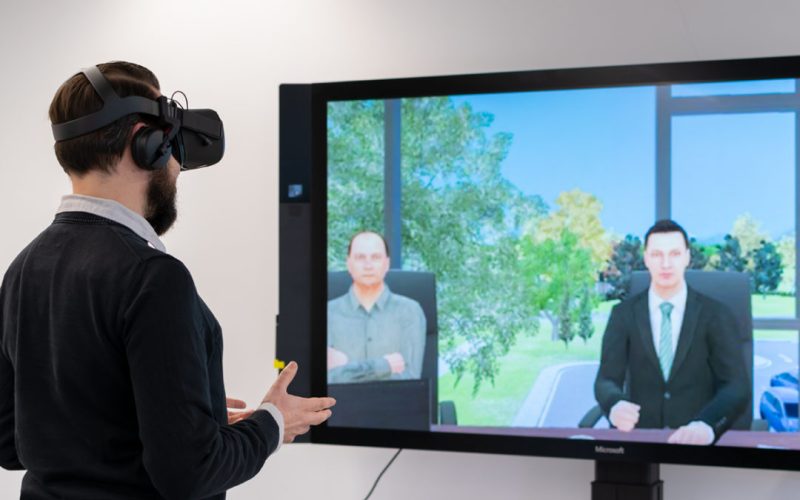A realistic negotiation simulation thanks to artificial intelligence and virtual reality: this is made possible by a new training game developed by the team at the InnoSÜD sub-project Sales Lab at Neu-Ulm University of Applied Sciences together with its corporate partner TriCAT. The aim of the game is to achieve certain goals in a realistic negotiation situation.
John and Paul don't like small talk: that's the first lesson that players have to learn in the InnoSÜD Sales Lab's virtual negotiation training programme. The reason for this is the artificial intelligence behind the two virtual characters, which makes them speak using voice output software - a little clumsy perhaps, but perfectly understandable. This requires the players to stick to the negotiation topic given to them by trainer Ringo in the virtual preliminary discussion. But as soon as it comes to payment terms, discounts, delivery dates and services, John and Paul get chatty.
The bot learns to speak
InnoSÜD scientist Barbara Dannenmann trained with the two of them: She "taught" the bot behind John and Paul almost 700 sentences. Students at the university analysed negotiation situations and transcribed the sentences that were said in them. The dialogues come from textbooks and training materials as well as Hollywood films such as the stock market epic The Wolf of Wall Street. The individual sentences were then entered into the software and assigned to a negotiation style.
"The special thing about artificial intelligence is that the players don't have to stick to a predetermined script like in a computer game," says Barbara Dannenmann, explaining the advantage of the technology. "Even if participants only say parts of the learnt sentences, the artificial intelligence can determine the probability of a statement belonging to a certain negotiation style and provide a suitable answer. As a result, the bot keeps learning new sentences and becomes more and more accurate. However, it doesn't understand everything - if the conversation strays too far from the topic of the negotiation, John and Paul point this out."
However, if the users manage to keep the negotiation goal in mind and set the right incentives, they can do business with John and Paul. The scenario developed by the team recreates an everyday scene in the business-to-business segment: A mechanical engineering company wants to sell production equipment. The negotiators can use various means to make the deal palatable to their virtual partners: for example, they can grant discounts, offer particularly attractive delivery and payment conditions or fast installation services. However, they must be careful not to offer more than the company allows.
The exact parameters of the negotiation could be adapted in future for specific uses of the training game, for example to take into account the practices in other sectors or specific company requirements. With such an application, the game could then be used in companies, universities and further education institutions.
Get to know negotiation styles in virtual reality
However, the aim of the game is not just to do business successfully with John and Paul, explains project manager Prof. Dr Alexander Kracklauer, Head of the Competence Centre for Growth and Sales Strategies at the university's Faculty of Business Administration and Economics: "During the negotiation situation, the bot analyses which negotiation style the participants use. The players can get to know each other better during training with the application, try out different negotiation styles and test which style suits them and achieves the best results."
This is also where the team sees the strength of the application. Role plays on negotiation situations are already part of seminars and training courses. However, training with the software would have the advantage that participants could repeat the situation at will without being subject to the time pressure and artificial framework of a seminar situation. Training in virtual reality could be a good addition here.
Source: innosued.de









